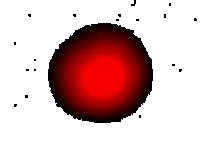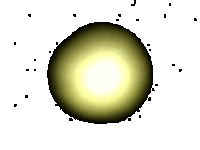 |
Stars come in various colors, depending upon how hot they are burning. Blue is the hottest, followed by white, then yellow and red.
Can your fantasy world have a blue, white, or red sun, rather than a 'normal' yellow sun? Possibly. I'll talk about each one.
A blue star is burning hydrogen just like our yellow sun, but at a much faster rate. It must be many times larger than our sun in order to have enough gravitational pressure to up the temperature to the blue range. This means it won't last as long (the whole a candle that burns twice as bright lasts half as long thing).
 |
What would a blue sun look like? Well, it would be a smaller disc, since the temperature is so much higher the planet needs to be father away to have a similar climate. But it would very bright, like the difference between a yellow incandescent and a blue-beam headlight.
 White stars come in two flavors: main and dwarf. A white main sequence star is just a star like our own, but a few times larger. It won't live as long as our sun, but should still be good for a few of billion years worth of stable solar energy. So no problem having a world orbiting a main sequence white star.
White stars come in two flavors: main and dwarf. A white main sequence star is just a star like our own, but a few times larger. It won't live as long as our sun, but should still be good for a few of billion years worth of stable solar energy. So no problem having a world orbiting a main sequence white star. White dwarves, on the other hand, are old stars that have already gone through the red giant phase. This means that any planet orbiting the star has been engulfed when the star expanded to a super-size red sun. So, there wouldn't be any stable planet orbiting a white dwarf star close enough for the solar energy of the dwarf to keep the world temperate.
White dwarves, on the other hand, are old stars that have already gone through the red giant phase. This means that any planet orbiting the star has been engulfed when the star expanded to a super-size red sun. So, there wouldn't be any stable planet orbiting a white dwarf star close enough for the solar energy of the dwarf to keep the world temperate. Red stars also come in two flavors: Giant and main. A red giant is a blue, white, or yellow star that has used up all of its hydrogen and is now burning helium. Red giants are huge, puffed up versions of the original star. Our own sun will become a moderately large red giant in about 5 billion years. It will expand and engulf the four inner planets (Mercury, Venus, Earth, and Mars). At that point, moons orbiting Jupiter might become life-supporting. But that phase will only last for a few million years at most. So, one could have such a world, but the life would probably need to come from somewhere else.
Red stars also come in two flavors: Giant and main. A red giant is a blue, white, or yellow star that has used up all of its hydrogen and is now burning helium. Red giants are huge, puffed up versions of the original star. Our own sun will become a moderately large red giant in about 5 billion years. It will expand and engulf the four inner planets (Mercury, Venus, Earth, and Mars). At that point, moons orbiting Jupiter might become life-supporting. But that phase will only last for a few million years at most. So, one could have such a world, but the life would probably need to come from somewhere else. Main sequence red stars are stars with a mass slightly less than our sun, 80% to 30% of our sun's mass. It burns cooler, and therefore has a red hue. These types of stars are quite common, probably the most common, and are very stable. So a fantasy world orbiting a main sequence red is no problem at all.
Main sequence red stars are stars with a mass slightly less than our sun, 80% to 30% of our sun's mass. It burns cooler, and therefore has a red hue. These types of stars are quite common, probably the most common, and are very stable. So a fantasy world orbiting a main sequence red is no problem at all.What would a red sun look like in the sky? It would be a larger disc than our own sun, and have an amber or orange hue. The infrared spectrum would be stronger than our own yellow sun, and therefore the sunlight would 'feel' hot.
What about smaller than a small red main sequence? Suns that small don't have enough gravitational pressure to cause nuclear fusion, and therefore don't give off light. So-called 'brown' and 'black' stars (not to be confused with a black hole), these stars give off infrared light only. A planet could orbit around such a star, and life could possibly exist, for the infrared heat could keep a planet from being a frozen hunk of rock.
 More info on stellar classification can be found here.
More info on stellar classification can be found here.

1 comment:
Cool! Thanks! I think I will go with a Blue Star. :)
Post a Comment